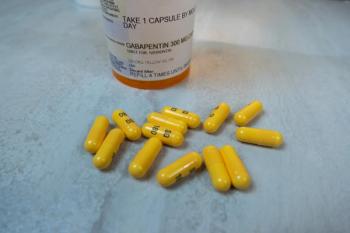
- Drug Topics October 2020
- Volume 164
- Issue 10
Breast Cancer Pain Management Options
Pharmacists are uniquely qualified to ensure patients receive sufficient pain relief.
October is Breast Cancer Awareness Month, and it is important to educate patients about early detection, treatment, and pain management strategies for the second-most-common cancer in women in the US.1,2
Current breast cancer treatment strategies include surgery, radiation, chemotherapy, hormone therapy, and targeted therapy.3 Adding targeted therapies to hormone therapy is a new strategy for advanced or metastatic hormone receptor–positive breast cancer to extend time until chemotherapy and prolong survival.3 Various early detection and treatment research programs are underway to develop enhanced technologies and novel therapies for breast cancer.3 Unfortunately, approximately 70% to 90% of individuals with metastatic breast cancer experience chronic pain.4 Breast cancer pain may be caused by the disease or result from surgery and treatments.4 Pharmacists can play an important role in breast cancer pain management through pharmacological therapy and integrative strategies.
Pharmacotherapy
One systematic review revealed the following posttreatment results for prevalence of persistent pain in patients with breast cancer: postsurgery (29.8%), postradiotherapy (27.3%), and postcombination therapy (21.8%).5 The National Comprehensive Cancer Network (NCCN) Clinical Practice Guidelines in Oncology for Adult Cancer Pain recommend the following “5 A’s” of outcomes for pain management goals:6
- Analgesia: Optimize analgesia.
- Activities: Optimize activities of daily living.
- Adverse effects (AEs): Minimize AEs.
- Aberrant drug taking: Avoid opioid misuse.
- Affect: Understand relationship between pain and mood.
Different types of pain include chronic, acute, and breakthrough (sudden increase in pain even while receiving pain medication). An interdisciplinary approach can help ensure patients are appropriately managed.6
Nonopioid Therapy
Patients experiencing mild pain should first receive nonopioids such as acetaminophen or nonsteroidal anti-inflammatory drugs (NSAIDs).6 It is important to educate patients receiving prescription opioids with acetaminophen to avoid taking any OTC products with the same active ingredient to prevent liver toxicity. Individuals should take the lowest effective dose of NSAIDs (eg, ibuprofen, naproxen) for the shortest duration, as many oncology patients may be at high risk for renal, gastrointestinal, cardiac, and bleeding AEs.6
Radiation therapy usually affects the skin, which can be similar to a severe sunburn resulting in redness, tenderness, blisters, and peeling.7 Patients should bathe and shower daily using warm water and a mild unscented soap, rinse the skin well, and pat with a dry, soft towel. Patients should use moisturizers when starting treatment to minimize any skin reactions and should select ones without fragrances or lanolin.7
Supplemental doses of analgesics should be given prior to procedures to minimize pain. Anxiolytics such as midazolam, lorazepam, or alprazolam can be given 30 to 60 minutes before a procedure to manage anxiety symptoms.6 Patients should be counseled to avoid driving or operating machinery when taking these medications.
Opioid Therapy
Individuals experiencing moderate-to-severe pain can receive opioid therapy for breast cancer pain, which should be initiated at the lowest effective dose that controls pain with the fewest AEs. Patients who are opioid naïve experiencing pain intensity greater than or equal to 4 or less than 4 but whose pain is not being adequately controlled can be started on a dose of 5 to 15 mg of oral morphine sulfate or 2 to 5 mg of intravenous morphine sulfate or equivalent. Opioid options include oxycodone immediate release, hydrocodone with acetaminophen, and hydromorphone. If 4 or more doses are needed per day, then a long-acting opioid can be added. Opioid dose reductions (reduce by 10%-20%) can be considered for patients that rarely need breakthrough medication, have managed an acute pain event, or experienced pain control through a nonopioid therapy.6
Patients should be monitored closely for opioid-related AEs including constipation, nausea and vomiting, pruritus, delirium, respiratory depression, motor and cognitive impairment, and sedation, especially when initiating and titrating therapy.6 Individuals receiving opioid therapy should be counseled to take laxatives to prevent constipation. When higher opioid doses are needed, then patients should be switched from combination products (including acetaminophen or aspirin) to pure opioids to reduce the risk of toxicity.6
Opioid-tolerant patients are defined as those receiving at least 25 mcg/hour fentanyl patch, at least 60 mg of morphine daily, at least 30 mg of oral oxycodone daily, at least 8 mg of oral hydromorphone daily, or an equianalgesic dose of another opioid for a week or longer.6 It is important to note that transdermal fentanyl should not be used for rapid opioid titration and should only be initiated after pain is managed by other opioids in opioid-tolerant patients. Fentanyl is typically the treatment of choice for individuals who are unable to swallow, patients with poor tolerance to morphine, and those with compliance issues.6
Opioids should be administered on a regular schedule for continuous pain with supplemental doses for breakthrough pain. Tramadol and tapentadol are atypical opioids and should be used with caution or avoided in patients taking other serotonergic or monoamine oxidase inhibitor–like medications due to an increased risk of serotonin syndrome.6 Methadone should be reserved for the management of chronic, not acute, pain and should not be titrated more frequently than every 5 to 7 days or longer, usually by 5 mg/dose or less.6
An electrocardiogram should be considered before patients start methadone, and it’s recommended to be performed prior to therapy in individuals with risk factors for corrected QT interval (QTc) prolongation (eg, taking medications that also prolong the QTc interval).6 Pharmacists should educate patients on the importance of storing opioids out of reach of children in a locked area and on appropriately disposing these medications if unused or expired.
Adjuvant Analgesics
Antidepressants and anticonvulsants are frequently used as adjuvant analgesics in combination with opioids for the treatment of neuropathic pain. Tricyclic antidepressants (eg, amitriptyline, imipramine, nortriptyline, desipramine) can be used as adjuvant therapy; however, individuals should be assessed for any cardiac issues prior to initiating treatment because these agents can cause QTc prolongation.6
Selective serotonin-norepinephrine reuptake inhibitors (SSNRIs) (eg, duloxetine, venlafaxine) are common adjuvant analgesics, and evidence supports the use of duloxetine for chemotherapy-induced peripheral neuropathy. Some clinical studies have shown an increased risk of breast cancer recurrence in patients treated with tamoxifen (treatment for hormone receptor–positive breast cancer) who are also taking selective serotonin reuptake inhibitors (SSRI) or SSNRI antidepressants versus those receiving tamoxifen monotherapy. The proposed mechanism of action is that SSRI and SSNRI antidepressants may inhibit the conversion of tamoxifen to its active metabolite, which can decrease the efficacy of tamoxifen. If concomitant use of an SSRI is required in a patient receiving tamoxifen, then a mild cytochrome P450 2D6 inhibitor (sertraline, citalopram, venlafaxine, escitalopram) should be used over a moderate-to-potent inhibitor (paroxetine, fluoxetine, fluvoxamine, bupropion, duloxetine).6
Gabapentin and pregabalin (Lyrica) are common anticonvulsants used as adjuvant analgesics. Gabapentin can reduce mucositis pain in patients receiving concomitant radiotherapy and chemotherapy. Patients with renal insufficiency should receive dose adjustments for gabapentin and pregabalin. Corticosteroids (eg, dexamethasone) can also be used as adjuvant agents to reduce swelling and manage pain. These medications should generally be taken in the morning to prevent nighttime insomnia. Topical agents (eg, lidocaine patch) can be applied daily as an adjuvant analgesic.6
Nonpharmacologic Options
Evidence suggests that in addition to pharmacologic interventions, integrative therapies can also be used for pain management, including physical therapy, exercise, heat and/or ice application, psychological services, massage, meditation, and yoga.6,8
Applying heat can help relieve muscle soreness, whereas cold can decrease pain by numbing the area. It is important to avoid applying cold or heat over any area where patients are receiving radiation therapy and for 6 months after treatment has ended. Physical therapy is especially important for patients undergoing radiation therapy for range-of-motion arm exercises to prevent scar tissue from forming. And because anxiety and depression can worsen pain, joining an emotional support group may help alleviate these symptoms.8
For references, visit drugtopics.com
References:
- Breast Cancer Awareness Month. National Breast Cancer Foundation Inc. Accessed August 26, 2020. https://www.nationalbreastcancer.org/breast-cancer-awareness-month
- How common is breast cancer? American Cancer Society. Updated January 8, 2020. Accessed August 26, 2020. https://www.cancer.org/cancer/breast-cancer/about/how-common-is-breast-cancer.html
- Advances in breast cancer research. National Cancer Institute. Updated June 18, 2020. Accessed August 27, 2020. https://www.cancer.gov/types/breast/research
- Breast cancer pain. Cleveland Clinic. Updated February 9, 2019. Accessed August 27, 2020. https://my.clevelandclinic.org/health/diseases/9006-breast-cancer-pain
- Wang K, Yee C, Tam S, et al. Prevalence of pain in patients with breast cancer post-treatment: a systematic review. Breast. 2018;42:113-127. doi:10.1016/j.breast.2018.08.105
- NCCN. Clinical Practice Guidelines in Oncology for Adult Cancer Pain, version 1.2018. Accessed August 28, 2020. https://www.nccn.org/professionals/physician_gls/pdf/pain.pdf
- Skin care guidelines while you are receiving radiation therapy. Memorial Sloan Kettering Cancer Center. Updated December 12, 2018. Accessed August 29, 2020. https://www.mskcc.org/cancer-care/patient-education/skin-care-guidelines-patients-receiving-radiation-therapy
- Non-medical treatments for pain. American Cancer Society. Updated January 3, 2019. Accessed August 29, 2020. https://www.cancer.org/treatment/treatments-and-side-effects/physical-side-effects/pain/non-medical-treatments-for-cancer-pain.html
Articles in this issue
about 5 years ago
Mask Wearing: A Small Sacrifice for the Greater Goodabout 5 years ago
Combatting the Common Coldabout 5 years ago
Pharmacists Offer Tips on Weight Management in Diabetesabout 5 years ago
Election 2020: What Pharmacy Needs from the Next Administrationabout 5 years ago
Celebrate the Pharmacy ProfessionNewsletter
Pharmacy practice is always changing. Stay ahead of the curve with the Drug Topics newsletter and get the latest drug information, industry trends, and patient care tips.





















































































































































